Modernization and its Profound Effects on Religion in East Asia
VerifiedAdded on 2022/09/25
|5
|994
|23
Essay
AI Summary
This essay explores the significant impact of modernization on religious practices and beliefs in East Asia. The paper examines how modernization has influenced cultural, political, and religious traditions, focusing on the rise of religious tolerance and the changes in dominant religions such as Buddhism, Islam, and Confucianism. It discusses the effects of science and technology on religious practices, including the adoption of technology in sermons and religious programs. The essay also highlights the resurgence of Hinduism and Buddhism while Islam declines in some regions. The analysis reveals the complex interplay between modernization, globalization, and religious diversity, offering insights into the evolving religious landscape of East Asia.
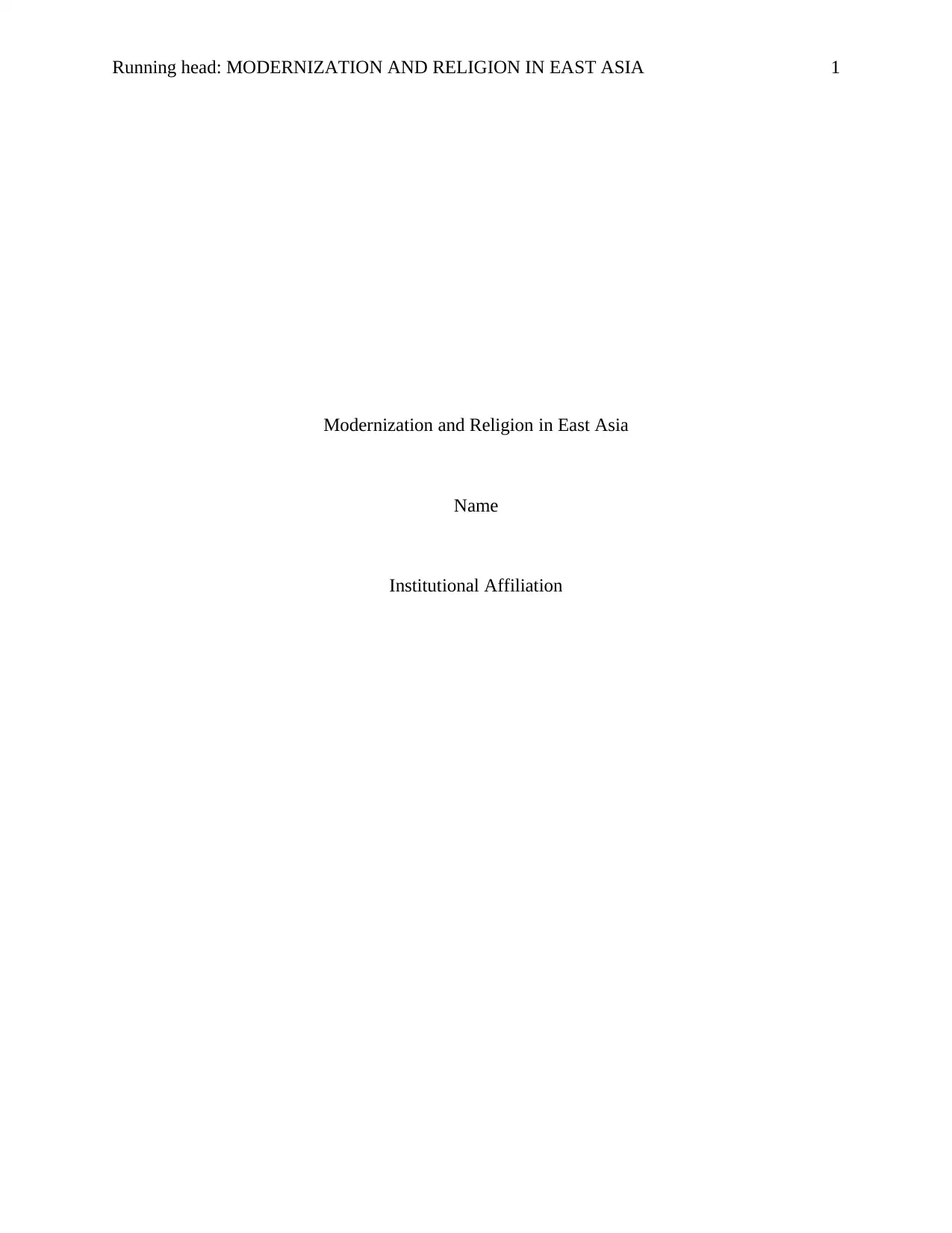
Running head: MODERNIZATION AND RELIGION IN EAST ASIA 1
Modernization and Religion in East Asia
Name
Institutional Affiliation
Modernization and Religion in East Asia
Name
Institutional Affiliation
Paraphrase This Document
Need a fresh take? Get an instant paraphrase of this document with our AI Paraphraser
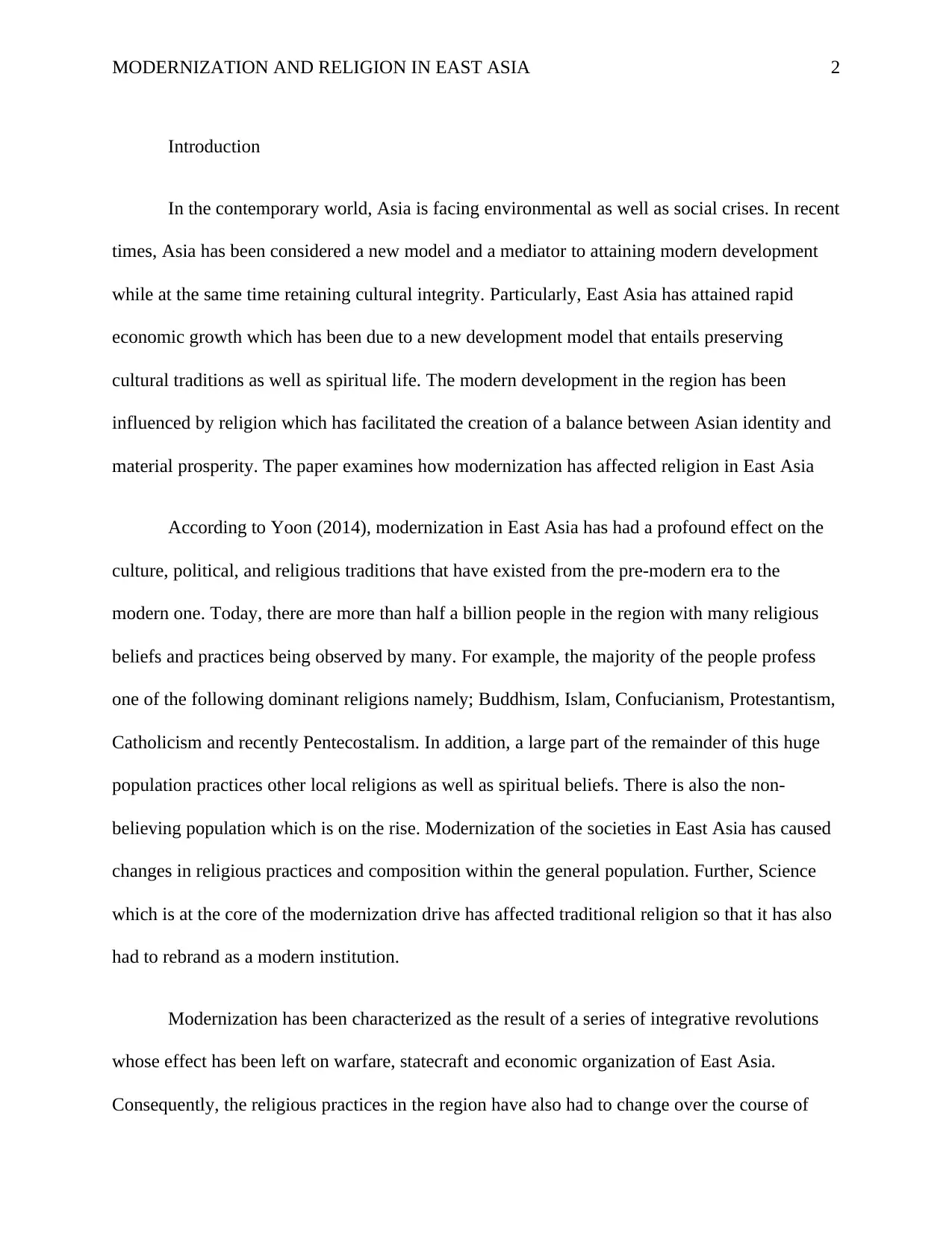
MODERNIZATION AND RELIGION IN EAST ASIA 2
Introduction
In the contemporary world, Asia is facing environmental as well as social crises. In recent
times, Asia has been considered a new model and a mediator to attaining modern development
while at the same time retaining cultural integrity. Particularly, East Asia has attained rapid
economic growth which has been due to a new development model that entails preserving
cultural traditions as well as spiritual life. The modern development in the region has been
influenced by religion which has facilitated the creation of a balance between Asian identity and
material prosperity. The paper examines how modernization has affected religion in East Asia
According to Yoon (2014), modernization in East Asia has had a profound effect on the
culture, political, and religious traditions that have existed from the pre-modern era to the
modern one. Today, there are more than half a billion people in the region with many religious
beliefs and practices being observed by many. For example, the majority of the people profess
one of the following dominant religions namely; Buddhism, Islam, Confucianism, Protestantism,
Catholicism and recently Pentecostalism. In addition, a large part of the remainder of this huge
population practices other local religions as well as spiritual beliefs. There is also the non-
believing population which is on the rise. Modernization of the societies in East Asia has caused
changes in religious practices and composition within the general population. Further, Science
which is at the core of the modernization drive has affected traditional religion so that it has also
had to rebrand as a modern institution.
Modernization has been characterized as the result of a series of integrative revolutions
whose effect has been left on warfare, statecraft and economic organization of East Asia.
Consequently, the religious practices in the region have also had to change over the course of
Introduction
In the contemporary world, Asia is facing environmental as well as social crises. In recent
times, Asia has been considered a new model and a mediator to attaining modern development
while at the same time retaining cultural integrity. Particularly, East Asia has attained rapid
economic growth which has been due to a new development model that entails preserving
cultural traditions as well as spiritual life. The modern development in the region has been
influenced by religion which has facilitated the creation of a balance between Asian identity and
material prosperity. The paper examines how modernization has affected religion in East Asia
According to Yoon (2014), modernization in East Asia has had a profound effect on the
culture, political, and religious traditions that have existed from the pre-modern era to the
modern one. Today, there are more than half a billion people in the region with many religious
beliefs and practices being observed by many. For example, the majority of the people profess
one of the following dominant religions namely; Buddhism, Islam, Confucianism, Protestantism,
Catholicism and recently Pentecostalism. In addition, a large part of the remainder of this huge
population practices other local religions as well as spiritual beliefs. There is also the non-
believing population which is on the rise. Modernization of the societies in East Asia has caused
changes in religious practices and composition within the general population. Further, Science
which is at the core of the modernization drive has affected traditional religion so that it has also
had to rebrand as a modern institution.
Modernization has been characterized as the result of a series of integrative revolutions
whose effect has been left on warfare, statecraft and economic organization of East Asia.
Consequently, the religious practices in the region have also had to change over the course of
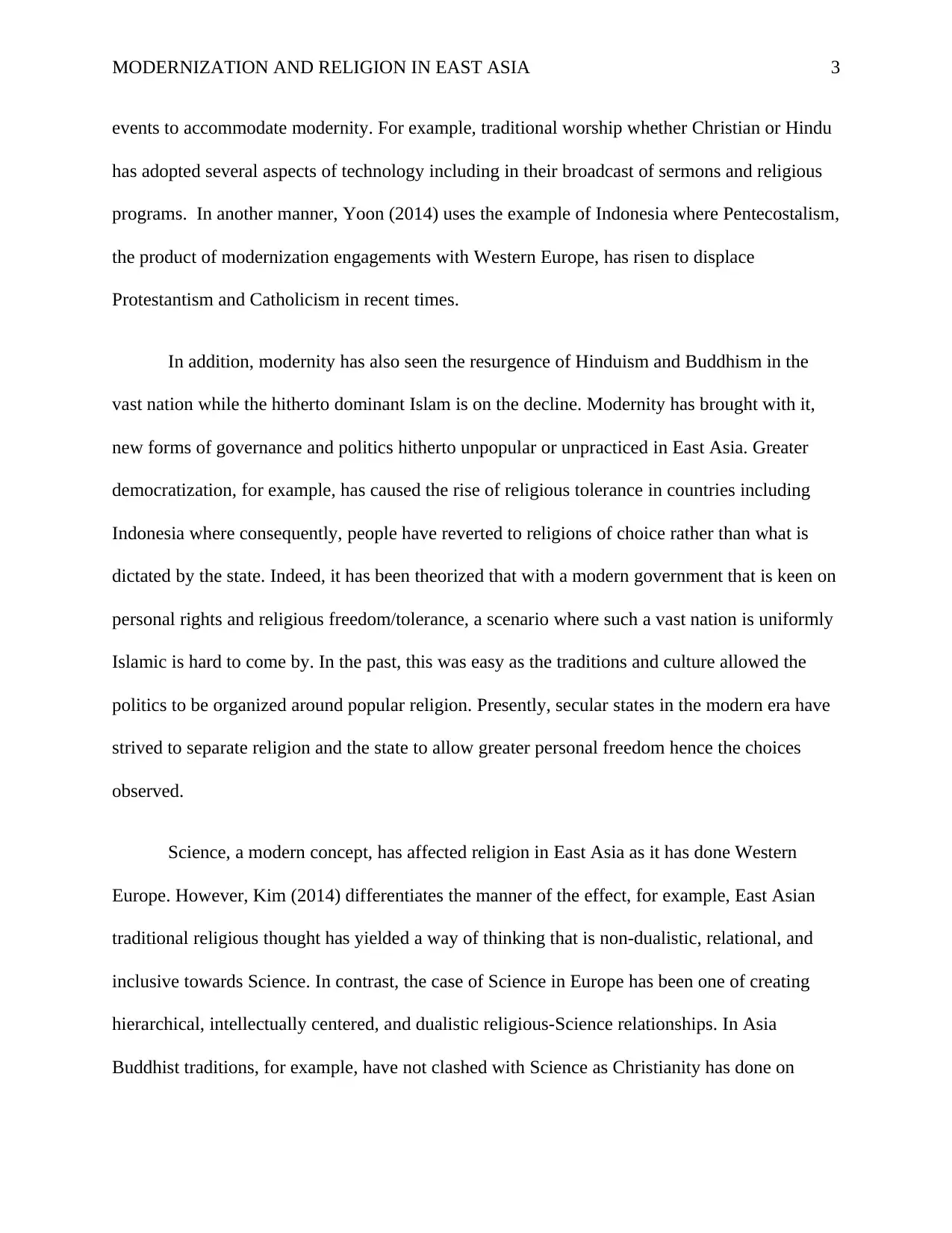
MODERNIZATION AND RELIGION IN EAST ASIA 3
events to accommodate modernity. For example, traditional worship whether Christian or Hindu
has adopted several aspects of technology including in their broadcast of sermons and religious
programs. In another manner, Yoon (2014) uses the example of Indonesia where Pentecostalism,
the product of modernization engagements with Western Europe, has risen to displace
Protestantism and Catholicism in recent times.
In addition, modernity has also seen the resurgence of Hinduism and Buddhism in the
vast nation while the hitherto dominant Islam is on the decline. Modernity has brought with it,
new forms of governance and politics hitherto unpopular or unpracticed in East Asia. Greater
democratization, for example, has caused the rise of religious tolerance in countries including
Indonesia where consequently, people have reverted to religions of choice rather than what is
dictated by the state. Indeed, it has been theorized that with a modern government that is keen on
personal rights and religious freedom/tolerance, a scenario where such a vast nation is uniformly
Islamic is hard to come by. In the past, this was easy as the traditions and culture allowed the
politics to be organized around popular religion. Presently, secular states in the modern era have
strived to separate religion and the state to allow greater personal freedom hence the choices
observed.
Science, a modern concept, has affected religion in East Asia as it has done Western
Europe. However, Kim (2014) differentiates the manner of the effect, for example, East Asian
traditional religious thought has yielded a way of thinking that is non-dualistic, relational, and
inclusive towards Science. In contrast, the case of Science in Europe has been one of creating
hierarchical, intellectually centered, and dualistic religious-Science relationships. In Asia
Buddhist traditions, for example, have not clashed with Science as Christianity has done on
events to accommodate modernity. For example, traditional worship whether Christian or Hindu
has adopted several aspects of technology including in their broadcast of sermons and religious
programs. In another manner, Yoon (2014) uses the example of Indonesia where Pentecostalism,
the product of modernization engagements with Western Europe, has risen to displace
Protestantism and Catholicism in recent times.
In addition, modernity has also seen the resurgence of Hinduism and Buddhism in the
vast nation while the hitherto dominant Islam is on the decline. Modernity has brought with it,
new forms of governance and politics hitherto unpopular or unpracticed in East Asia. Greater
democratization, for example, has caused the rise of religious tolerance in countries including
Indonesia where consequently, people have reverted to religions of choice rather than what is
dictated by the state. Indeed, it has been theorized that with a modern government that is keen on
personal rights and religious freedom/tolerance, a scenario where such a vast nation is uniformly
Islamic is hard to come by. In the past, this was easy as the traditions and culture allowed the
politics to be organized around popular religion. Presently, secular states in the modern era have
strived to separate religion and the state to allow greater personal freedom hence the choices
observed.
Science, a modern concept, has affected religion in East Asia as it has done Western
Europe. However, Kim (2014) differentiates the manner of the effect, for example, East Asian
traditional religious thought has yielded a way of thinking that is non-dualistic, relational, and
inclusive towards Science. In contrast, the case of Science in Europe has been one of creating
hierarchical, intellectually centered, and dualistic religious-Science relationships. In Asia
Buddhist traditions, for example, have not clashed with Science as Christianity has done on
⊘ This is a preview!⊘
Do you want full access?
Subscribe today to unlock all pages.

Trusted by 1+ million students worldwide
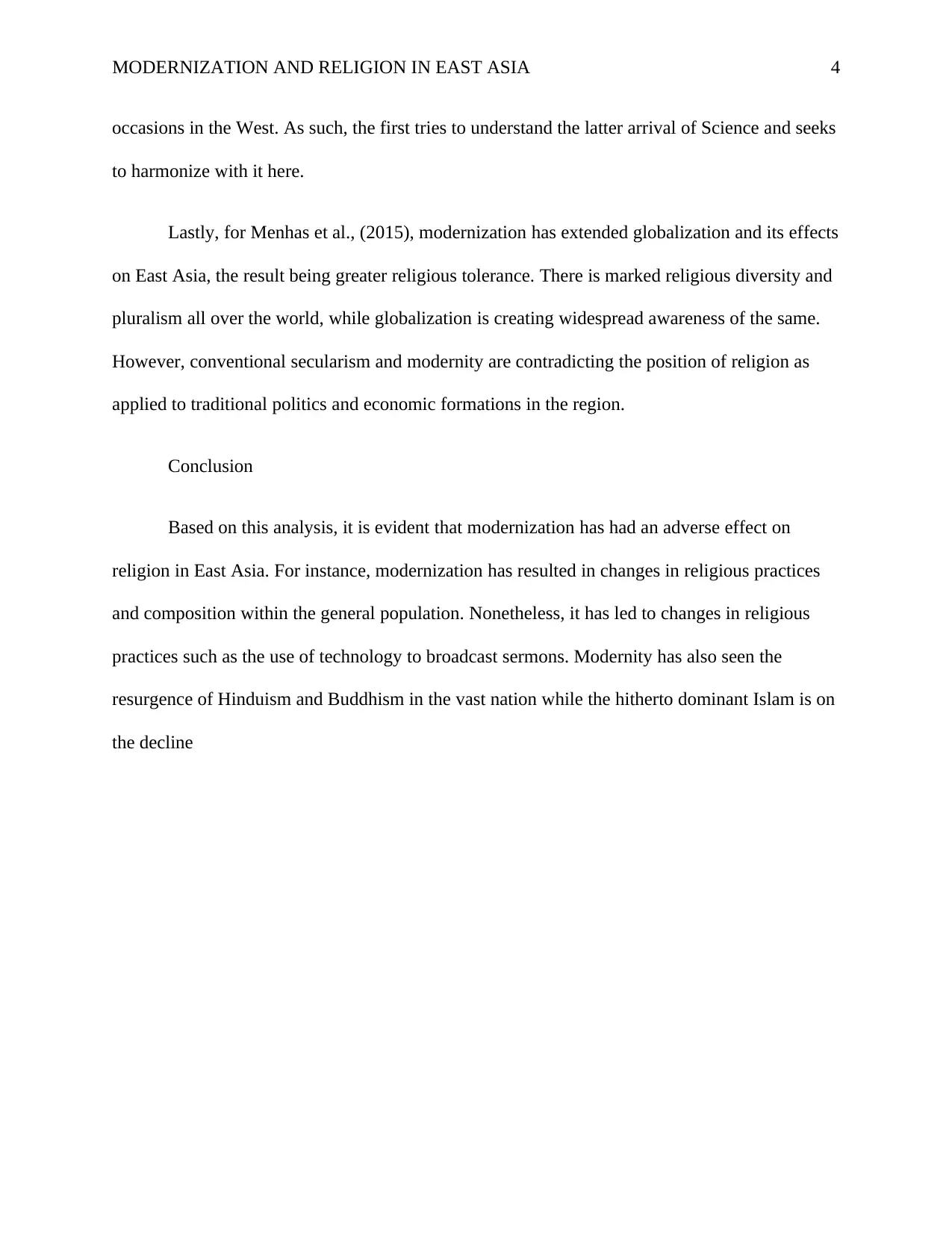
MODERNIZATION AND RELIGION IN EAST ASIA 4
occasions in the West. As such, the first tries to understand the latter arrival of Science and seeks
to harmonize with it here.
Lastly, for Menhas et al., (2015), modernization has extended globalization and its effects
on East Asia, the result being greater religious tolerance. There is marked religious diversity and
pluralism all over the world, while globalization is creating widespread awareness of the same.
However, conventional secularism and modernity are contradicting the position of religion as
applied to traditional politics and economic formations in the region.
Conclusion
Based on this analysis, it is evident that modernization has had an adverse effect on
religion in East Asia. For instance, modernization has resulted in changes in religious practices
and composition within the general population. Nonetheless, it has led to changes in religious
practices such as the use of technology to broadcast sermons. Modernity has also seen the
resurgence of Hinduism and Buddhism in the vast nation while the hitherto dominant Islam is on
the decline
occasions in the West. As such, the first tries to understand the latter arrival of Science and seeks
to harmonize with it here.
Lastly, for Menhas et al., (2015), modernization has extended globalization and its effects
on East Asia, the result being greater religious tolerance. There is marked religious diversity and
pluralism all over the world, while globalization is creating widespread awareness of the same.
However, conventional secularism and modernity are contradicting the position of religion as
applied to traditional politics and economic formations in the region.
Conclusion
Based on this analysis, it is evident that modernization has had an adverse effect on
religion in East Asia. For instance, modernization has resulted in changes in religious practices
and composition within the general population. Nonetheless, it has led to changes in religious
practices such as the use of technology to broadcast sermons. Modernity has also seen the
resurgence of Hinduism and Buddhism in the vast nation while the hitherto dominant Islam is on
the decline
Paraphrase This Document
Need a fresh take? Get an instant paraphrase of this document with our AI Paraphraser
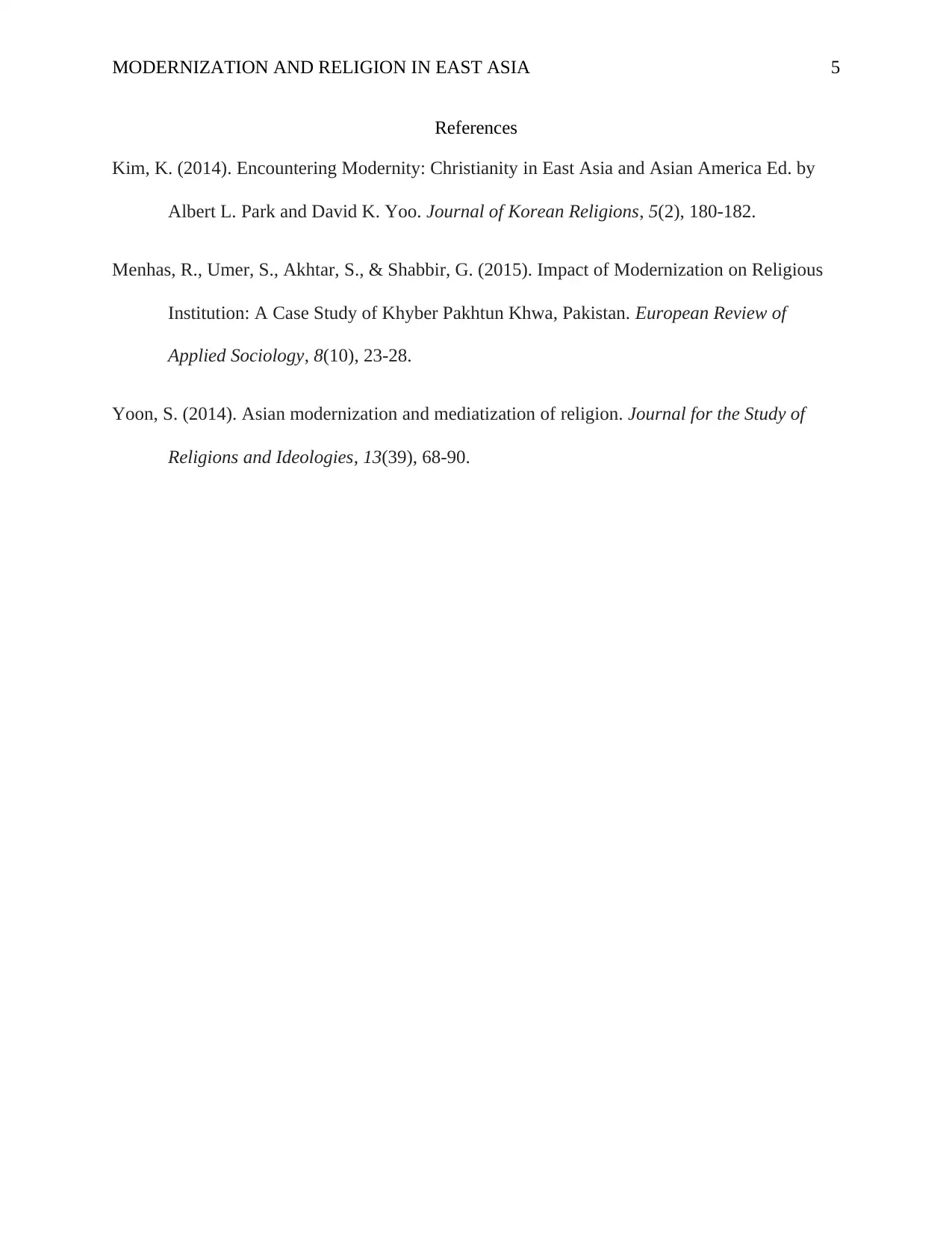
MODERNIZATION AND RELIGION IN EAST ASIA 5
References
Kim, K. (2014). Encountering Modernity: Christianity in East Asia and Asian America Ed. by
Albert L. Park and David K. Yoo. Journal of Korean Religions, 5(2), 180-182.
Menhas, R., Umer, S., Akhtar, S., & Shabbir, G. (2015). Impact of Modernization on Religious
Institution: A Case Study of Khyber Pakhtun Khwa, Pakistan. European Review of
Applied Sociology, 8(10), 23-28.
Yoon, S. (2014). Asian modernization and mediatization of religion. Journal for the Study of
Religions and Ideologies, 13(39), 68-90.
References
Kim, K. (2014). Encountering Modernity: Christianity in East Asia and Asian America Ed. by
Albert L. Park and David K. Yoo. Journal of Korean Religions, 5(2), 180-182.
Menhas, R., Umer, S., Akhtar, S., & Shabbir, G. (2015). Impact of Modernization on Religious
Institution: A Case Study of Khyber Pakhtun Khwa, Pakistan. European Review of
Applied Sociology, 8(10), 23-28.
Yoon, S. (2014). Asian modernization and mediatization of religion. Journal for the Study of
Religions and Ideologies, 13(39), 68-90.
1 out of 5
Related Documents
Your All-in-One AI-Powered Toolkit for Academic Success.
+13062052269
info@desklib.com
Available 24*7 on WhatsApp / Email
![[object Object]](/_next/static/media/star-bottom.7253800d.svg)
Unlock your academic potential
Copyright © 2020–2025 A2Z Services. All Rights Reserved. Developed and managed by ZUCOL.




